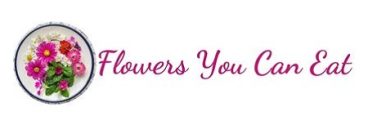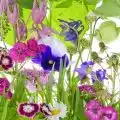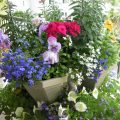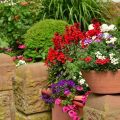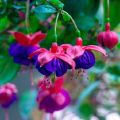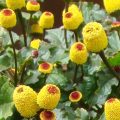
Growing Bee Balm in your bee friendly edible flower garden is a no brainer. It is an easy plant to grow, needs very little maintenance, and its edible flowers are amazingly versatile. The scarlet bee balm, Monarda didyma, has stunning bright red flowers and is a delight in both the garden and the kitchen.
In this article, I’m going to be giving you some tips on growing Bee Balm in your edible flower garden. I’ll also show you how you can use these delightful bright edible flowers for garnish.
Table of Contents

Bee Balm, a Bee and Humming Bird Magnet
The Monarda didyma produce fabulous, long-lasting, and showy edible flowers and are a wonderful inclusion in any bee friendly edible flower garden.
Growing bee balm will give you floral displays that are are one of the best for attracting vital pollinators like bees, butterflies, and hummingbirds to the garden.
Hummingbirds are one of the main pollinators for the Monarda species as they can effectively reach the nectar in the tubular flower petals with their long, slender beaks.
I am a huge fan of growing bee balm, with an entire section of my backyard dedicated to these gorgeous specimens. So, if you’re looking for a dramatic floral display that is an excellent pollinator magnet, the Monarda genus is a perfect edible flower addition. I’m sure you’ll love it as much as the birds and the bees!
Monarda didyma is one of the most popular species of bee balm and highly valued for its bright red edible flowers. Together with its leaves it offers many culinary uses for those interested in establishing an edible garden.
I will also discuss how to harvest and use the flowers and leaves in the kitchen so you can make the most of your plants.
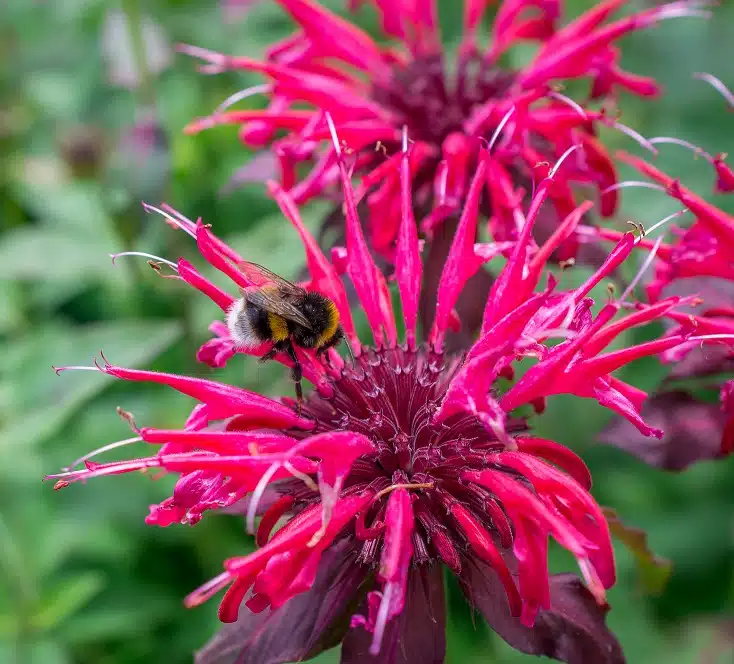
Growing Bee Balm and How to Use Bee Balm
The Monarda genus consists of many beautiful flowering plants and belongs to the mint family, Lamiaceae. There are several flower colors in the Monarda species including red, white, pink, and purple. Monarda fistulosa is a stunning purple flowering species and is also very popular for making tea.
Common names for Monarda didyma include bergamot, horsemint, and scarlet bee balm. It is a perennial plant which grows up to a meter tall. It flowers abundantly, and spreads effectively by developing underground rhizomes.
Monarda didyma or the Scarlet Bee Balm has a dense and compact growing habit, perfect for filling out tough spots in the garden. Tall and slender stems emerge prolifically from the base of the plant, adorned with vibrant scarlet-red flower heads and fragrant opposite leaves. The dramatic and unique flower displays look like little pops of fireworks in the garden, offering eye-catching summertime exhibits.
Ways to Use Bee Balm: How to Use Monarda Didyma
Scarlet bee balm produces edible flowers and leaves with many uses.
The plant has a long history of medicinal and culinary uses. It’s a source of phenol thymol which is an antisceptic, and Native Americans used the leaves to treat wounds and to bee stings. Hence it was named bee balm!
Bee balm also has antimicrobial properties and is thought to be soothing to the digestive tract and used to treat issues like gas, nausea, and muscle spasms.
Alternatively, the flowers and leaves can also be used as a herb seasoning for wild game and other meat dishes.
The leaves taste like a delicious mild peppermint with hints of oregano and can be used as a colorful alternative to either of these herbs.
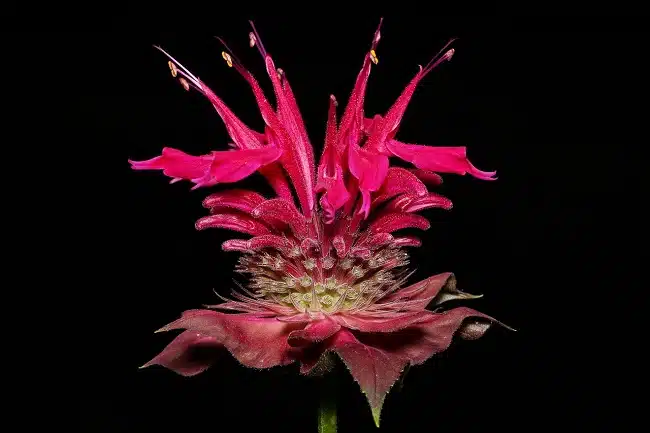
How to Use Bee Balm Flowers and Leaves
My favorite use of these vibrant edible flowers of Monarda didyma is as garnishes in cocktails, salads, and desserts. The bright scarlet color adds a dramatic and lively visual addition to a dish. The flavor of the scarlet bee balm pairs very well with fruits, particularly watermelon and strawberries.
The flowers and leaves are also commonly used to make herbal teas using the cold brew method. This tea is commonly known as Oswego tea. Both the fresh and dried leaves can be used.
If you’re thinking about edible flowers for drinks then scarlet bee balm would be a great choice. It is very versatile and so get creative and see how your bee balm can enhance your food and drinks. The stunning color alone will bring a sense of excitement to your plate.
How to Grow Bee Balm
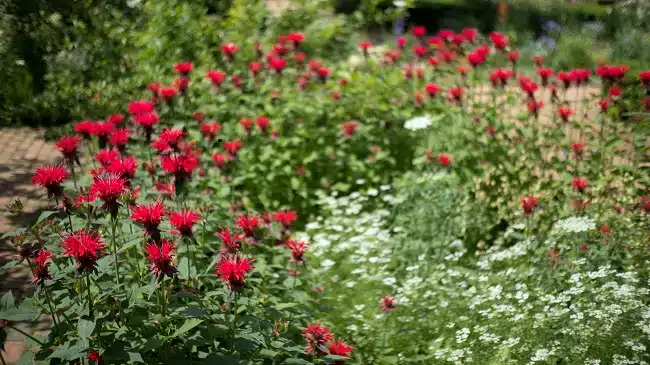
Growing bee balm is pretty easy as they are resilient plants and can be grown from either seeds or cuttings. However, the easiest form of propagation is by division of its root tubers.
Let’s have a look at some of the basic growing requirements that will allow your bee balm to thrive and grow its best.
Best Growing Conditions for Monarda Didyma
This species thrives in full sun positions, planted in moist soil that drains well and is rich in organic matter. It will tolerate some shade in hotter climates and although is drought resistance it will flourish if kept watered.
When and Where to Plant Bee Balm
If you’re growing Bee Balm, then I recommend planting it in spring once the chances of frost have passed.
If you have the space, plant in groups for maximum colorful impact, and space the plants about 2 feet apart to allow for adequate growing room.
Pick a planting site in your garden that gets full sun for at least 6 hours each day. The location should allow for good air circulation to avoid any disease issues.
Zones 4 to 9 are ideal.
How Long Does Bee Balm Bloom?
Scarlet bee balm (Monarda didyma) has a long-blooming time between late spring and midsummer, offering gardens about 2 to 3 months of vibrant floral displays.

How to Propagate and Prevent Invasion of Bee Balm
Scarlet bee balm plants are best propagated using seeds or division of their rhizomatous root systems.
Growing Monarda Didyma from Seeds
- No pre-treatment is required for seeds as they germinate readily
- Sprinkle seeds onto moist potting soil, gently pressing them into the mix
- Mist lightly after sowing then place the seeds in a sheltered position that gets some morning sun and afternoon shade
- You can also place them indoors so long as they receive bright indirect light
- Keep the soil slightly moist while the seedlings develop
- Transplant out when seedling look strong enough to cope with all day sun
Propagating Monarda Didyma using Division
- Dividing up a mature plant is considered the easiest and best way to propagate the bee balm plant
- In spring, young shoots should emerge around the plant
- Gently dig up a portion of your new bee balm shoots to expose the roots
- Divide the plant to get a healthy stem with roots and some leaves
- Replant the divided shoot into fresh moist soil in your garden or a quality potting mix in containers
Preventing Invasion
The rhizomatous roots of this species are known to spread quickly, often leading to the plant becoming invasive if left unchecked.
The best way to avoid this is to regularly divide established bee balms to keep them centralized to a particular location.
How to Harvest Bee Balm
Harvest your flowers and leaves around mid-morning once the dew has evaporated as this will allow for the best flavor. Use immediately if your plan is to use them fresh to garnish or as a salad addition.
If you’re looking to dry these flowers, simply clip the base of the stalks you would like to harvest. You can gather bunches of stems at a time as well. Tie the stems together and hang them to dry or pluck leaves and petals individually from the stalks to dry them in a dehydrator.
Once the flowers and leaves have dried, you can use them immediately or store them in a glass jar away from direct sunlight until you are ready to use them.
Try to avoid crushing or damaging them as this could lead to reduced flavors.
Wrapping Up My Growing Bee Balm Guide

Growing bee balm not only brings the pleasure of a stunning floral dispIay in your garden, it also provides a great attraction to butterflies, birds and bees. They are always fascinating to watch as well as providing a thriving ecosystem.
I hope you feel inspired to grow your own bee balm plants as they truly have a lot to offer in both gardens and kitchens.
The vibrant blooms will easily elevate your outdoor spaces while the aromatic leaves offer lovely fragrance and texture.
Just try to make sure your bee balm has enough sun and moisture in the soil, and you should have a thriving addition in no time.
